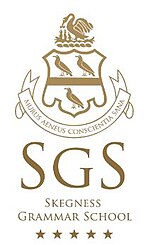Skegness ( skeg-NESS) is a seaside town and civil parish in the East Lindsey District of Lincolnshire, England. On the Lincolnshire coast of the North Sea, the town is 43 miles (69 km) east of Lincoln and 22 miles (35 km) north-east of Boston. With a population of 21,128 as of 2021, it is the largest settlement in East Lindsey. It incorporates Winthorpe and Seacroft, and forms a larger built-up area with the resorts of Ingoldmells and Chapel St Leonards to the north. The town is on the A52 and A158 roads, connecting it with Boston and the East Midlands, and Lincoln respectively. Skegness railway station is on the Nottingham to Skegness (via Grantham) line.
The original Skegness was situated farther east at the mouth of The Wash. Its Norse name refers to a headland which sat near the settlement. By the 14th century, it was a locally important port for coastal trade. The natural sea defences which protected the harbour eroded in the later Middle Ages, and it was lost to the sea after a storm in the 1520s. Rebuilt along the new shoreline, early modern Skegness was a small fishing and farming village, but from the late 18th century members of the local gentry visited for holidays. The arrival of the railways in 1873 transformed it into a popular seaside resort. This was the intention of The 9th Earl of Scarbrough, who owned most of the land in the vicinity; he built the infrastructure of the town and laid out plots, which he leased to speculative developers. This new Skegness quickly became a popular destination for holiday-makers and day trippers from the East Midlands factory towns. By the interwar years the town was established as one of the most popular seaside resorts in Britain. The layout of the modern seafront dates to this time and holiday camps were built around the town, including the first Butlin's holiday resort which opened in Ingoldmells in 1936.
The package holiday abroad became an increasingly popular and affordable option for many British holiday-makers during the 1970s; this trend combined with declining industrial employment in the East Midlands to harm Skegness's visitor economy in the late 20th century. Nevertheless, the resort retains a loyal visitor base. Tourism increased following the recession of 2007–09 owing to the resort's affordability. In 2011, the town was England's fourth most popular holiday destination for UK residents, and in 2015 it received over 1.4 million visitors. It has a reputation as a traditional English seaside resort owing to its long, sandy beach and seafront attractions which include amusement arcades, eateries, Botton's fairground, the pier, nightclubs and bars. Other visitor attractions include Natureland Seal Sanctuary, a museum, an aquarium, a heritage railway, an annual carnival, a yearly arts festival, and Gibraltar Point nature reserve to the south of the town.
Despite the arrival of several manufacturing firms since the 1950s and Skegness's prominence as a local commercial centre, the tourism industry remains very important for the economy and employment but the tourism service economy's low wages and seasonal nature, along with the town's aging population, have contributed towards high levels of relative deprivation. Poor transport and communication links are barriers to economic diversification. Residents are served by five state primary schools and a preparatory school, two state secondary schools (one of which is selective), several colleges, a community hospital, several churches and two local newspapers. The town has a police station, a magistrates' court and a lifeboat station.










